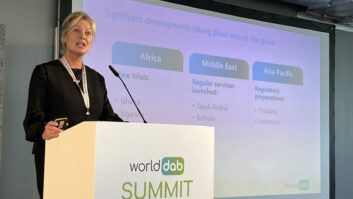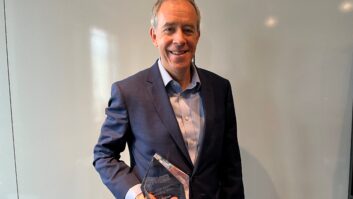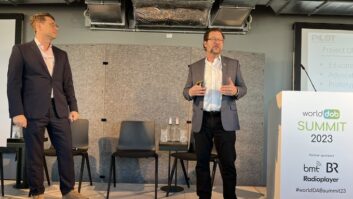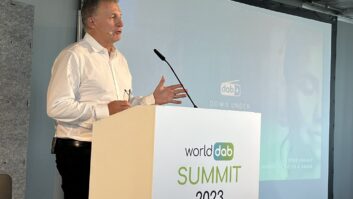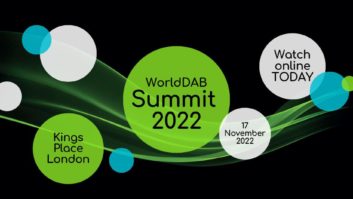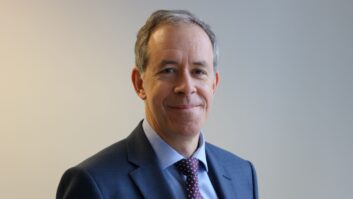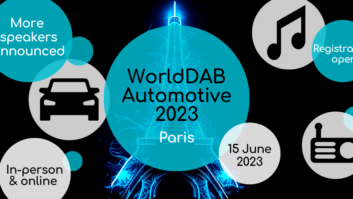
In the run up to the WorldDAB 2016 General Assembly, which takes place Nov. 9–10 in Vienna, Radio World spoke to WorldDAB President Patrick Hannon about DAB developments in 2016 and where he expects progress in 2017.
Radio World: At last year’s General Assembly in London you set out three goals (“international development, DAB in cars and “European support”). Within this context, how has DAB evolved over the last 12 months and have these objectives been met?
Patrick Hannon: Internationally, DAB has made good progress in both established and emerging markets.
In established markets, the highlights of the last 12 months include:
• Norway counting down to the start of its digital switchover, which starts in January 2017.
• The United Kingdom launching its second national commercial multiplex — to great acclaim from audiences.
• Germany preparing a draft roadmap to digital switchover for discussion next year.
We have also seen strong progress in Switzerland (major ad campaign launching next year in preparation for Digital Switchover), Denmark (Government confirmation that DSO is seen as inevitable) and continued growth of DAB+ in Netherlands, Italy and Australia.
In emerging markets, the highlight has been the announcement by the French regulator of a timetable for rolling out DAB+ across metropolitan France. Calls for applications have been issued for Lille, Lyon and Strasbourg — with services expected on air in the second half of 2017. In neighboring Belgium, plans have been announced for a federal DAB+ launch across Flanders and Wallonia in early 2018.
Elsewhere we have seen national DAB+ services start in Slovenia and a DAB+ trial is due to start in Latvia this month. In the Asia Pacific region, the biggest news has been the launch of a DAB+ trial in Indonesia. In South Africa, we are waiting to hear feedback about the outcome of the trial in Johannesburg and Pretoria.
The automotive sector has seen a very good year for DAB radio. We just announced new figures on automotive adoption rates — and we expect to see growing adoption rates in all established markets. The U.K. continues to lead the way with 86 percent of new cars now coming with DAB as standard. This means that DAB in the car is a tried and tested technology. With the first countries starting to switch-off FM signals, we expect to see rapid progress in other European markets and Australia in the next 18 months.
At the European level, there is a growing body of voices arguing for more active support from the European Commission. In Germany, senior politicians and broadcasters are promoting the case that radio receivers that can display a station’s name should be required to have both FM and digital capability from 2019 onwards. The Dutch Government has made a similar submission to the European Commission and in Italy, regulator AGCOM is also arguing for its introduction. France already has a law, which requires receivers to have digital capability once digital radio coverage exceeds 20% of the population – likely to be achieved next year. Over the last 12 months we have had increasingly constructive discussions with the Commission and European parliamentarians. Our goal now is to convert these discussions into active support from the Commission.
RW: The theme of this year’s General Assembly is “New content. New markets.” Please tell us a little about what you plan to cover in Vienna.
Hannon: We’ve got an excellent line-up this year with a wide range of speakers and countries represented. The keynote session features Andreas Geiss from the European Commission and he’ll be joined by; Heike Raab, plenipotentiary for Federal and European Affairs, for Media and Digital Affairs of the Land of Rhineland-Palatinate in Germany; Øyvind Christensen, deputy director general, Media Department, Ministry of Culture, Norway; Ian O’Neill, OBE, head of Radio; head of Television, Department for Culture, Media & Sport (DCMS), U.K. and Patrice Gélinet, board member of the Council, Conseil supérieur de l’audiovisuel (CSA) in France.
We’ll be hearing from broadcasters and content providers who are using DAB to deliver new stations and business models that would not be possible in on analogue platforms. Some great examples include Absolute Radio, who have launched several stations dedicated to particular decades of music, and Angel Radio who are using one of the U.K.’s “mini muxs” in Portsmouth and both will be speaking in Vienna next week. We’ll also be joined by Jimmy Buckland from Wireless Group to discuss their investment in digital radio — the recent acquisition by News Corp is a strong vote of faith in radio in the digital age.
Other sessions include a look at existing and developing markets for DAB, in particular central and Eastern Europe where we’ve seen some encouraging progress in the last few months. We’ll also be hearing the latest news from the automotive sector with new stats from JATO and GFK will be providing an update on the receiver market.
RW: As regards digital radio on a global level, where has DAB advanced most, and where it has not? Where do you expect major advances in the next year?
Hannon: In advanced markets we’ve seen a change in government commitment, from new networks in France to German and Dutch initiatives at the European level. In Belgium the Walloon government is financing a significant part of the investments needed for the DAB+ rollout in French speaking Belgium and in the U.K., digital listening continues to grow. In Australia digital listening goes from strength to strength and the next step is the regional rollout.
In Central and Eastern Europe there are trials in Latvia, new services in Slovakia and Slovenia’s first DAB+ network was announced just over a month ago.
In the next year I’d expect advances in the Gulf States, South Africa and South East Asia. In each of these regions there have been successful trials and in many we have either held digital radio workshops, or worked alongside local partners to do so. In Indonesia this year Radio Republik Indonesia (RRI) launched permanent DAB+ digital radio services in Jakarta.
RW: There is some talk about the complementary use of more than one digital radio standard in certain countries. Do you see this as feasible?
Hannon: The focus today is very much on establishing DAB as the core future platform for radio — starting with Europe and Australia and then expanding internationally, for example into the Gulf States, South Africa, Turkey, Malaysia, Thailand and Indonesia. The difficulty with complementary digital terrestrial radio standards is the lack of receivers capable of receiving standards other than DAB.
RW: On Jan. 11 the first of many FM transmitters will be shut down in Norway as part of the country’s nationwide switchover to DAB. Do you feel preparation and dissemination of information has been adequate to ensure a smooth transition and consumer acceptance?
Hannon: Norway is leading the way as the first country doing a digital switchover and I’ve been impressed with the content being produced and the ways they’ve been getting the message out to both consumers and the industry. A lot of work has already happened ahead of switchover but of course there’s more to do — as we saw with the switch to digital television, there will always be people who are harder to reach and who are resistant to the change.
The radio.no site has an incredible amount of information and the team has just announced that they are hitting the road in the buildup to switchover in January. At the General Assembly we’ll be hearing from the broadcaster NRK and the Ministry of Culture in Norway on the latest developments.
RW: How do you see the relevance of OTA radio, given the onset of streaming and mobile devices?
Hannon: We see radio over IP as complementary to DAB, though to date the vast majority of listening remains via broadcast platforms. For example, in the U.K., only 8 percent of radio listening is via apps or online.
For listeners on the move, IP does provide an alternative platform, however, for linear radio there are some limitations — for example, the cost of data packages for mobile devices and the impact of battery life; a further limitation is the reliability of mobile networks in emergency situations. If too many people try to use a mobile network simultaneously there is a risk that it may crash. That said, we do see a very strong case for hybrid radio, which combines broadcast delivery of linear radio with access to related online information and services via IP.





